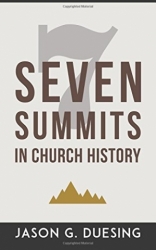Review by Cody Glen Barnhart
I clicked the power button on the top of my iPad, closed its case, and grabbed my Dr. Pepper from the flight attendant. I closed my eyes for a second, trying to digest what I had read before pulling another book out of my backpack.
“It was fine,” I thought to myself. “Dr. Duesing has a helpful writing style.” It was the best I could come up with at the time. And as I was about to concede to being disappointed by an author I deeply admire, it hit me: I read the book wrong.
Towards the end of his book, Duesing quotes what J. I. Packer wrote in his popular book Knowing God: “Someone who touched down on the top of Everest in a helicopter (could such a thing be) would not at that moment feel anything like what Hillary and Tensing felt when they stood on the same spot after climbing the mountain.” When I first turned through the book’s pages, I was unfairly expecting Duesing to be my sherpa, guiding me to the summit. But I’m not so sure that was his goal.
In his new book Seven Summits in Church History, Dr. Jason G. Duesing pilots us to the tops of seven theological mountains – mountains that only the locals know well enough to hold a conversation about. Make no mistake: Duesing isn’t trying to replace the climb. He’s trying to convince you the view is worth the climb.
Duesing clearly sized up his task, for he is careful to be forthright about the task of the historian. He holds nothing back, reminding us that the student of church history must be wary of self-reliance, noting that, “finding oneself in a position where the demands outpace one’s ability gives the student (and the professor) the opportunity to learn the necessity of seeking God’s help in things like reading comprehension, attention span, and clear thinking.” We cannot do this task in a vacuum. We need the gospel to raze our pride as we attempt to learn from the giants before us. Church history is like scaling Annapurna I; we can’t do it on our own.
The Seven Summits
Duesing chooses seven of the church’s noblest majesties: Augustine, Luther, Calvin, Hubmaier, Edwards, Carey, and Henry. As previously implied, a few of these guys are subject to study, particularly Augustine, Luther, Calvin, and Edwards. These summits are accessible to climb towards, but they’re ones that everyone should conquer. The works of Augustine, Luther, Calvin, and Edwards are necessary reading for any informed Christian in the 21st Century. But when’s the last time you read anything that mentioned Balthasar Hubmaier, William Carey, or Carl F. H. Henry? I commend Duesing for the flying us to these summits. Though they might not be the flashiest or most-photographed mountaintops in church history, these men are worthy of our attention – true men of the terrain, if you will. They can be tougher climbs (I’m currently trying to tackle Henry, and to be frank the climate is dry as could be), but the views they offer are unmatched. One of the book’s greatest strengths is Duesing’s thoughtfulness in selecting seven subjects worth our time.
Helpful Practicality
Given the unfamiliarity of most readers with Hubmaier, Carey, and Henry, I was initially disappointed with the length and depth of the book. It felt lacking. But I don’t want to second my mistake of imposing a duty on the book, giving it a responsibility beyond its scope. This is a travel pamphlet to familiarize us tourists of church history with the hotspots, and in this, Duesing succeeds. This volume is, if nothing else, a winsome case for studying the lives of these seven men. But I think there’s a little more substance here. After capping each mountaintop, Duesing provides a list of books for further reading, an important inclusion in a work like this. Had Duesing neglected to show us these trails – fully fleshed books that have carved out a path for us – Seven Summits of Church History would leave our vacation in the mountains to memory. But it doesn’t. Duesing lets us take the climb home with us.
Plotting the Journey
And this is the true beauty of Duesing’s work. Seven Summits of Church History wasn’t groundbreaking. It didn’t rock my philosophy of church history (although the opening chapter is insightful in this regard). But it does offer the reader a brief survey of church history through the years, and it allows students unfamiliar with church history an opportunity to get their feet wet with the best of them. It kills hesitancy. It tries to pick the novice climber up and encourage him. Yes, you’ll have to train, and it might not always be easy – and Duesing’s not afraid to tell you about the hard pills to swallow concerning each of these men. But the climb is worth it, and Duesing helps you plan how you’ll accomplish it.
If you’re looking for a new trek, I’d recommend visiting Duesing’s book. He might recommend a summit you’d never considered. His influence convinced me to pick up Henry months ago, and it’s changed the way I’ve processed Christianity and culture. If you’re willing to listen to Duesing’s recommendations – he has been through the church history ringer, for the record – you just might enjoy the climb. And it very well could change your worldview.
Cody Glen Barnhart is a student at Midwestern Baptist Theological Seminary and is a contributor at servantsofgrace.org.
